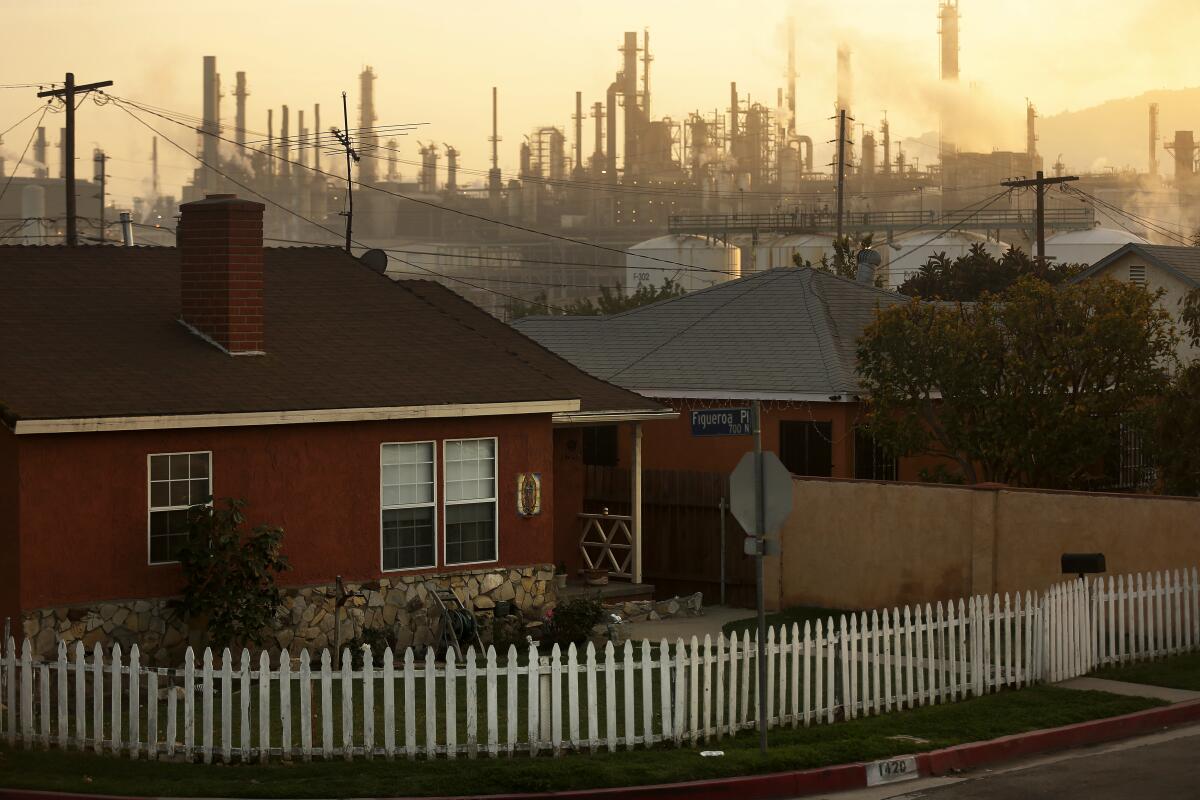Op-Ed: California may ban new oil wells near homes. Let’s eliminate the existing problem while we’re at it

- Share via
A few months ago, the two of us joined California First Partner Jennifer Siebel Newsom at the Boys & Girls Club in Wilmington to show her places where oil wells are poisonously close to where children play, learn and live. Then late last month, Gov. Gavin Newsom heeded the demands of frontline residents when he stood at this same site and announced a plan to prevent new oil drilling operations within 3,200 feet of homes, schools, playgrounds and hospitals.
That draft regulation is a huge step for California’s future away from toxic fossil fuels. But the fight’s not over.
Neighborhood drilling is a problem that plagues millions of California residents — who are disproportionately Black, Latinx, Asian immigrant, Indigenous and low-income. And Los Angeles continues to be home to one of the largest urban oil fields in the country.
Newsom’s plan is crucial, but it leaves some important gaps to resolve. This draft regulation would prevent only future oil wells within 3,200 feet of California residents, with no such assurance for the people living near tens of thousands of existing wells. Communities like Wilmington will continue to face the impacts of dangerous drilling if regulators and elected officials don’t step up and strengthen this health rule. We need stronger action to curb toxic pollution from existing wells and, ultimately, to phase out fossil fuel extraction across the state.
Because the truth is: No community should be treated as a sacrifice zone. That means the governor must end neighborhood drilling everywhere.
For years, scientists and public health experts have warned that families and workers exposed to pollution from fossil fuel extraction face an increased risk of asthma, respiratory disease, preterm births, cancer and even dying from COVID-19. These experts say that a “setback” is needed to put distance between our homes and schools and toxic oil and gas extraction sites to protect from these harms. But while the science has been clear for nearly a decade, and while Colorado, North Dakota, Texas and Wyoming have already required at least some setback, our state’s public policy has lagged behind.
Even getting to this moment was not easy. It took 40,000 public comments; dedication from community residents, leaders and climate activists; overwhelming public support demonstrated by multiple polls; two legislative attempts in Sacramento narrowly defeated by oil profiteers; major decisions in the city and county of Los Angeles to begin phasing out oil drilling; years of engagement with regulators; many toxic tours; and decades of cancer, asthma and neurological diseases endured by frontline communities.
Having arrived at this draft regulation, which is open for public comment until Dec. 21, the Newsom administration must champion the strongest possible outcome. That means not only resisting attempts by the oil and gas industry to weaken the 3,200-foot buffer zone requirement for new wells, but also expanding the proposed rule to eliminate existing wells. We know oil and gas executives will fight to weaken this rule with scare tactics and misinformation. That’s why the administration needs to remain steadfast in protecting communities from these dangers.
This is an opportunity to advance climate, environmental and economic justice. As our state moves beyond oil, we must also support communities and workers in the transition — by investing in safety net programs, job training and good union jobs that make communities and workers whole. Putting in place essential public health and safety protections for all Californians is the only way forward to a healthier, greener and more equitable future.
Jane Fonda is an activist and Academy Award-winning actor. Darryl Molina Sarmiento is the executive director of Communities for a Better Environment and a member of the Voices in Solidarity Against Oil in Neighborhoods coalition.
More to Read
A cure for the common opinion
Get thought-provoking perspectives with our weekly newsletter.
You may occasionally receive promotional content from the Los Angeles Times.










